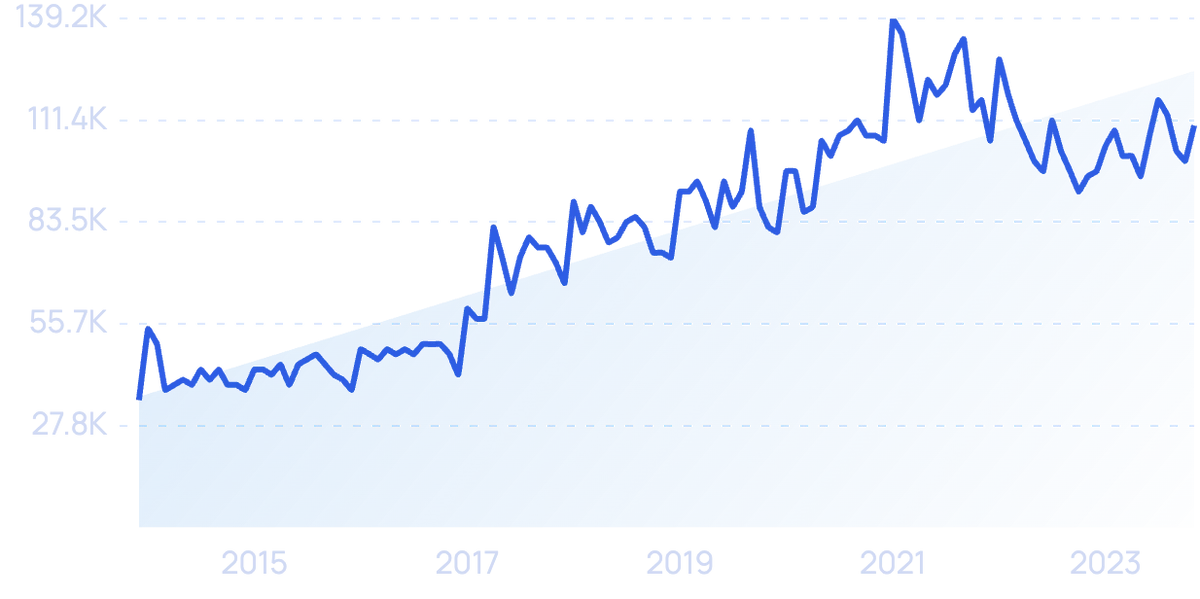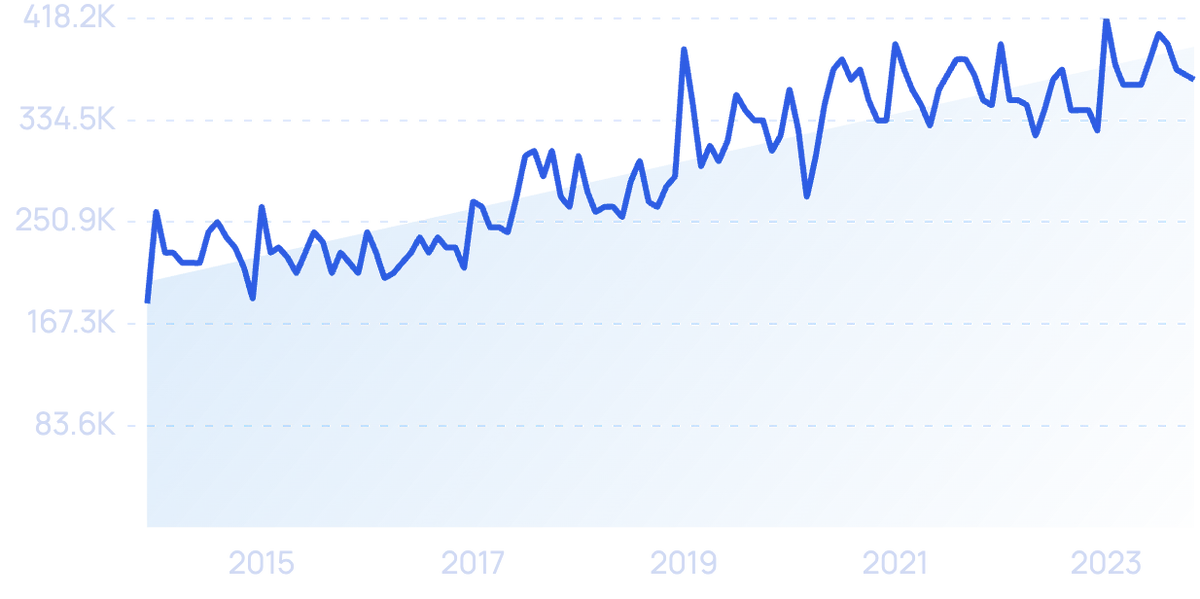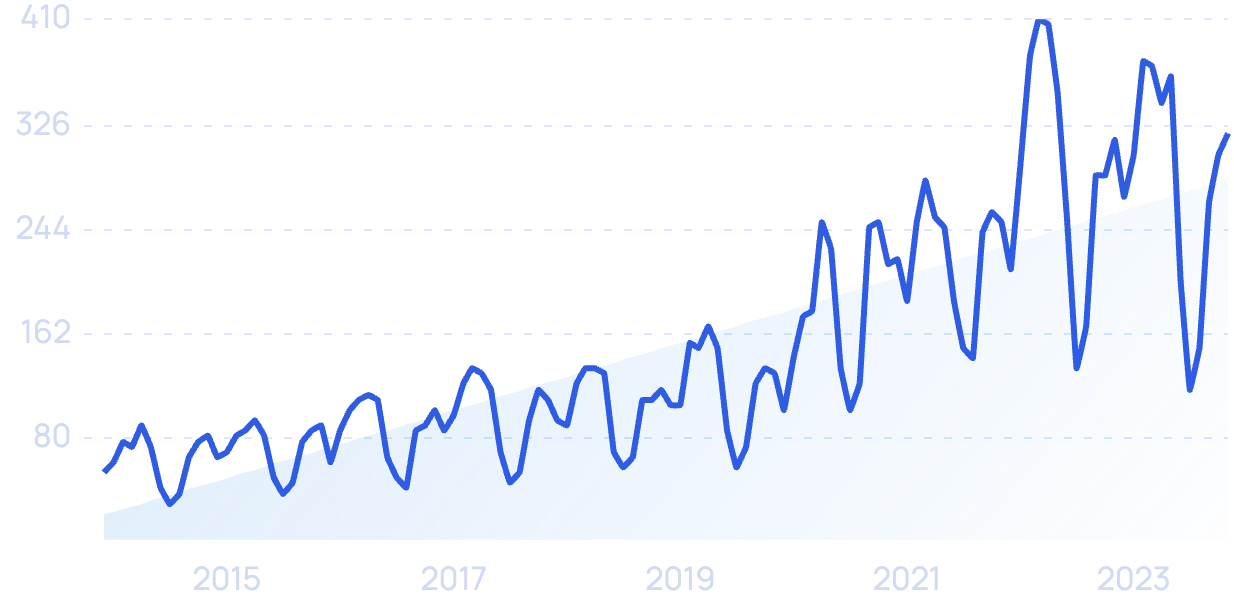
7 Top Pet Industry Trends (2025 & 2026)
Here are 7 important trends in the pet industry for 2025 and beyond.
The global pet industry is projected to reach $300 billion by 2030.
The question is: which trends will drive this growth?
From pet food to supplements, this list will help you see what's coming around the corner in the pet space.
Build a winning strategy
Get a complete view of your competitors to anticipate trends and lead your market
1. Pet Supplements Take Off
The pet supplement industry is set to hit $1.05 billion by 2027, according to an analysis by Grand View Research.
Examples of trending pet supplements include dog vitamins, cat fish oil, and dog probiotics
But one specific area that's growing quickly is pet probiotics.
Searches for "dog probiotics" are up 91% over the last 5 years.
Probiotic treats can help pets suffering from digestive issues and food allergies.
Probiotics for dogs and cats have also become popular on TikTok: videos mentioning the product have over 386 million views on the platform.
This trend is heavily driven by the “humanization of pets”. Meaning that people are starting to feed their pets the same type of food they eat themselves.
People are now paying more attention to their gut health (approximately 33% of people say they try to consume gut-friendly probiotics daily).
And these people are starting to add gut-supporting products to their pet’s diets.
In fact, approximately 7% of pet owners purchased a gut-supporting formula last year.
2. New Product Categories Emerge
The pet industry has traditionally been made up of a handful of product categories:
- Food
- Toys
- Beds
- Leashes
- Hygiene
- Pet grooming
But we're starting to see significant amounts of innovation in pet product R&D.
Specifically, entrepreneurs aren't simply launching variations of existing products.
They're creating entirely new pet care product categories.
Want to Spy on Your Competition?
Explore competitors’ website traffic stats, discover growth points, and expand your market share.
For example pet wipes.
Searches for "pet wipes" have grown 103% over the last 5 years.
Pet wipes are essentially moist towelettes used on pets after going to the bathroom. Although a relatively new category, Amazon already has nearly 300 brands of pet wipes for sale.
Another growing pet product category is pet toothpaste.
"Cat toothpaste" searches have risen by 71% over 5 years.
Oral hygiene products for pets are nothing new. But new products (like cat toothpaste) are coming out for owners that want to ensure that their pet's teeth and gums are in tip-top shape.
Litter-robot is another brand looking to create a new category in the pet industry.
Shot of the Litter-Robot 3.
Litter-Robot sells a battery-powered, Wi-Fi-connected litterbox that self-cleans after every use. At $500 per unit, this product also taps into a pet industry trend that we'll talk about next: luxury pet products.
According to Semrush data, Litter-Robot gets 1.6 million monthly visits from 1.1 unique visitors.
Visit our pet startup directory for a list of some of the fastest-growing brands within the space.
3. High-End Products For Pets Go Mainstream
No matter the product: if it will make their pets happier, there’s a group of owners who will buy it.
And that includes relatively expensive luxury products.
For example, The Bear & The Rat, a startup that makes frozen yogurt for dogs is sold in Whole Foods stores nationwide. It competes with Nestlé’s Purina Frosty Paws.
Pretty Litter is perhaps the best example of a high-end pet product.
Pretty Litter is a brand of kitty litter that changes color based on a cat’s urine pH levels.
The company, which has branding that largely targets millennials and Gen Z consumers, claims that the product helps cat owners detect illnesses in their cats, like worms, metabolic acidosis, or a UTI.
Pretty Litter is also noteworthy because, unlike basically every other kitty litter on the market, their product isn’t available in pet stores or supermarkets.
Instead, they sell their product exclusively via a monthly subscription.
Pretty Litter product in action.
Cat enclosures are another example of a luxury pet product on the rise.
Cat enclosures are fenced-in areas designed to help cats get time outdoors. While reducing the risk of escape or danger.
"Cat enclosure" searches have grown steadily (by 79%) over the last 10 years.
Certain cat enclosures can cost upwards of a thousand dollars. Which makes them part of the high-end pet product trend.
Semrush makes it easy to find new potential luxury pet products that are trending.
With the Ecommerce Keyword Analytics app, you can research keywords across major online retailers to find important insights, such as search volume, clicks, and total orders.
You can also find out how a product is performing by analyzing the keyword to see the number of product page visits, "Add to basket events," and conversions. This helps you gauge a product's conversion potential to determine if its a fad or a trend worth monitoring.
4. Increasing Number of Pet Food Niches
According to Pet Biz Marketer, pet food makes up about 3/4s of all pet industry sales.
We're noticing pet food brands gaining market share via niche pet foods.
And startups aiming to get traction in the space by launching completely new types of pet food.
One of the fastest-growing niche pet food categories right now is freeze-dried dog food.
Search growth for "freeze dried dog food" is up 79% over the last half-decade.
Freeze-dried dog food is just like it sounds: it's dog food that's freeze-dried to extend its shelf life.
Top-down view of freeze-dried dog food.
And many freeze-dried dog food brands (like Bixbi), contain raw food ingredients, like organ meat and veggies.
These ingredients are difficult to package and ship in pet food form. Hence the rise of freeze-dried pet food.
PetFoodIndustry.com reports that sales for "non-traditional pet food formats" (like freeze-dried) are growing faster than traditional pet food.
Raw dog food is another growing pet food niche.
According to a survey conducted by the University of Guelph Ontario Veterinary College, 66% of dog owners and 53% of cat owners feed their pets raw food.
This trend is reflected in the search trend data.
Google searches for "raw dog food" are up 216% over 10 years.
5. Pet Owners Increasingly Opt For DTC
Like ecommerce in general, pet owners turn to online retailers for selection, convenience, and price.
One of the leaders in the pet DTC space is the pet supply ecommerce brand Chewy.com.
Chewy's reported revenue in 2021 was $10 billion, a 12% increase compared to the year before.
Amazon is also looking to tap into the pet product DTC trend.
Screenshot from Amazon's popular "pet supplies" category.
In fact, Amazon already sells a reported $3.6 billion annually in pet food alone.
6. The Pet Insurance Space Continues to Grow
Pet insurance is one of the most interesting pet industry trends in 2024.
Searches for "pet insurance" are growing slowly but steadily at 100% over the last 10 years.
Globally, the pet insurance industry reached $9.4 billion in 2022 and is expected to grow at a compound annual growth rate of 17.04% through 2030.
That explains why the AI-powered insurer Lemonade launched its own pet insurance coverage in 2020.
Lemonade is getting into the growing pet insurance space.
Pet-dedicated competitors in the space include Healthy Paws, GoPetPlan, and the non-profit ASPCA.
According to Exploding Topics Analytics figures from October 2025, ASPCA features in the top 10 most-visited veterinary websites in the US.
7. Pet Owners Prefer Natural Food Brands
A survey of 2,181 pet owners discovered that 43.6% prioritize the health of their pet's foods over their own.
One brand tapping into this trend is Because Animals.
Searches for natural pet food and supplement brand Because Animals are up 500% over 10 years.
Because Animals specializes in healthy pet treats.
Especially focusing on factors that human owners tend to look for in their own food, like organic ingredients and omega-3 content.
Other growing natural pet food brands include Open Farm and Lily's Kitchen.
Conclusion
That's it for our list of important trends impacting the pet space.
The one thread tying almost all of these trends together is: pet health and wellness.
It's clear that "pet parents" are increasingly concerned about the health of their pets. And that they're willing to spend money to maximize the health of their furry friends.
As pet ownership continues to increase, we can expect the industry to grow with it.
You may also like:
Stop Guessing, Start Growing 🚀
Use real-time topic data to create content that resonates and brings results.
Exploding Topics is owned by Semrush. Our mission is to provide accurate data and expert insights on emerging trends. Unless otherwise noted, this page’s content was written by either an employee or a paid contractor of Semrush Inc.
Share
Newsletter Signup
By clicking “Subscribe” you agree to Semrush Privacy Policy and consent to Semrush using your contact data for newsletter purposes
Written By


Josh is the Co-Founder and CTO of Exploding Topics. Josh has led Exploding Topics product development from the first line of co... Read more














